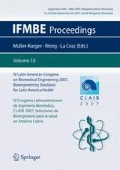Abstract
Current approaches for auditory screening are usually based on the Brainstem Auditory Evoked Potentials or on the Otoacoustic Emissions, and hence are not able to detect pathologies that affect higher auditory centers. Therefore, the Middle Latency Auditory Evoked Potential (MLAEP) was investigated as a neurophysiologic acoustic threshold measure by using the “Evoked Potential Detector” (EPD) as an Objective Response Detection technique. The EEG was collected from ten adults during monaural click stimulation (left ear, using contralateral masking noise) with different sound pressure levels. Based on the statistical distribution of EPD under the null hypothesis (absence of response), the use of the critical value considering EEG as a colored noise and fitting the shape parameters for a Beta distribution resulted in an objective detection of MLAEP with a better specificity and a similar sensitivity than considering EEG as a white noise. Full detection over all the casuistry occurred for stimulation levels as low as those found in literature using expert-based analysis, particularly for the derivation contralateral to the stimulation. This finding suggests the use of EPD for detecting MLAEP response as an auxiliary tool for determining objectively the neurophysiologic acoustical threshold level.
Access this chapter
Tax calculation will be finalised at checkout
Purchases are for personal use only
Preview
Unable to display preview. Download preview PDF.
References
Chiappa MD (1997) Brain Stem Auditory Evoked Potentials: Methodology, In: Evoked Potentials in Clinical Medicine, 3 ed, Lippincott-Raven Publishers, New York, 157–282.
Zaeyen EJB, Infantosi AFC, Souza MN (2002) Avaliação da audição em Recém-nascidos: Estado atual e perspectiva, In: Clínica de Perinatologia, 2/3: 501–530.
Rapin I, Gravel J (2003) Auditory neurophaty, physiologic and pathologic evidence calls for more diagnostic specificity. Int J Ped Otorhinol 67: 707–728.
Shapiro SM, Nakamura H (2001), Bilirubin and auditory system. J Perinatol 21-suppl.1: S52–5; discussion: S59–62.
Liégois-Chauvel C, Musolino A, Badier JM et al. (1994) Evoked potentials recorded from the auditory cortex in man: evaluation and topography of the middle latency components. Electroenc Clin Neurophysiol 92: 204–214.
Smith DI, Lee FS, Mills JH (1989) Middle latency response: Frequency and intensity effects. Hearing Research 42: 293–303.
Author information
Authors and Affiliations
Editor information
Editors and Affiliations
Rights and permissions
Copyright information
© 2007 Springer-Verlag Berlin Heidelberg
About this paper
Cite this paper
Cagy, M., Infantosi, A.F.C., Zaeyen, E.J.B. (2007). Detecting the Mid-latency Auditory Evoked Potential during Stimulation at Several Different Sound Pressure Levels. In: Müller-Karger, C., Wong, S., La Cruz, A. (eds) IV Latin American Congress on Biomedical Engineering 2007, Bioengineering Solutions for Latin America Health. IFMBE Proceedings, vol 18. Springer, Berlin, Heidelberg. https://doi.org/10.1007/978-3-540-74471-9_11
Download citation
DOI: https://doi.org/10.1007/978-3-540-74471-9_11
Publisher Name: Springer, Berlin, Heidelberg
Print ISBN: 978-3-540-74470-2
Online ISBN: 978-3-540-74471-9
eBook Packages: EngineeringEngineering (R0)

